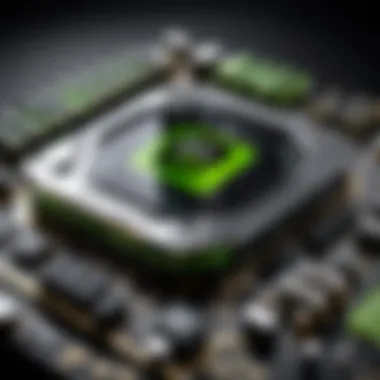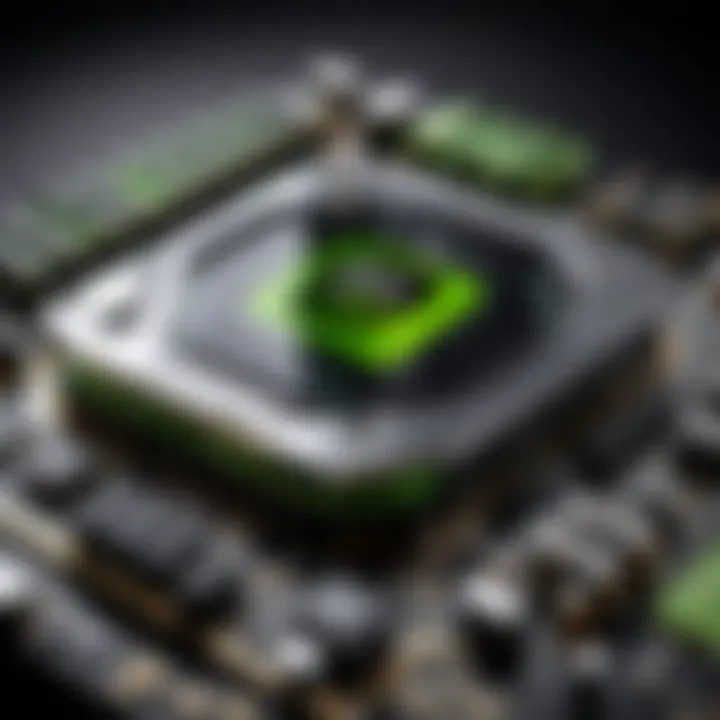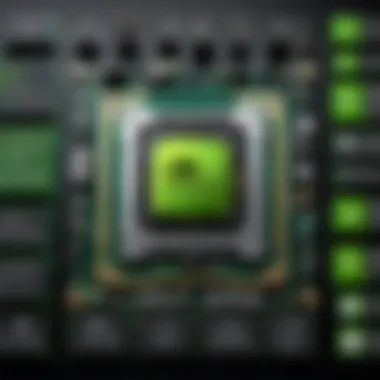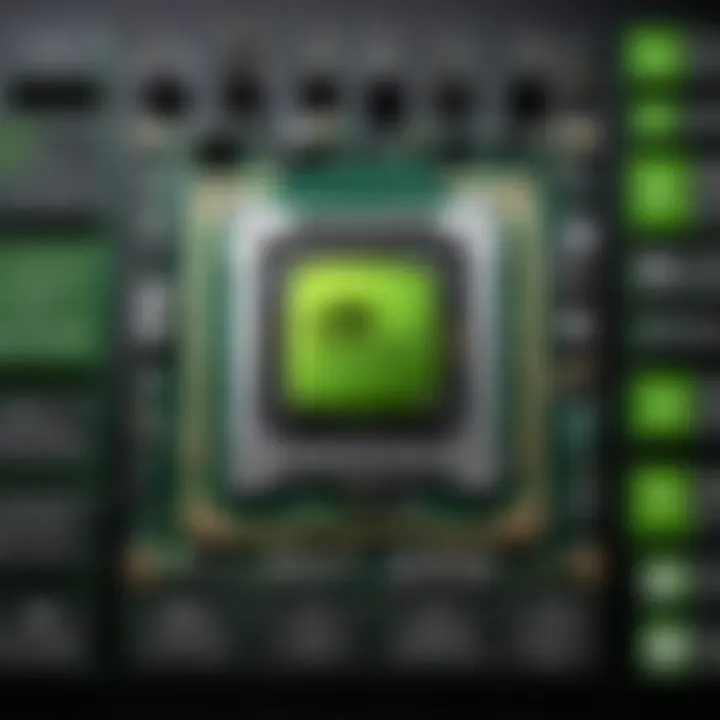Exploring NVIDIA Supercomputer GPUs: An In-Depth Review


Intro
In a world where computational tasks burgeon with an insatiable thirst for speed and efficiency, NVIDIA supercomputer GPUs stand at the forefront, pioneering advancements that often leave other technologies trailing in the dust. These powerful graphics processing units have become synonymous with high-performance computing, driving innovations in artificial intelligence, data processing, and scientific research. This overview aims to shed light on the intricate architecture and remarkable capabilities of NVIDIA's GPUs, contextualizing their impact in today’s tech-driven society.
As we navigate through this exploration, we will dissect key specifications, analyze performance metrics, and illustrate real-world applications. This will not just be an insight into the technology, but rather a deep dive into how these systems are redefining what's possible across multiple sectors. \n\n> "NVIDIA GPUs have transformed the pace of innovation across industries, serving as the backbone for advanced computing."
Our discourse will primarily appeal to IT professionals and tech enthusiasts alike, seeking to grasp the potential of NVIDIA GPUs within the realms of supercomputing. Prepare to unravel the depths of this robust hardware and witness how it reshapes our computing landscape.
Features Overview
Delving into the features that set NVIDIA supercomputer GPUs apart from their competitors provides a solid foundation for understanding their significance in high-performance computing.
Key Specifications
When examining the specs, several notable points emerge:
- CUDA Cores: NVIDIA's architecture boasts thousands of these cores, allowing for parallel processing at levels unprecedented in previous technologies.
- Tensor Cores: Specialized for AI workloads, these cores enhance performance in deep learning applications significantly.
- Memory Bandwidth: With GDDR6X memory technology, NVIDIA GPUs ensure rapid data transfer rates, which is crucial for handling large datasets efficiently.
- Framework Support: Compatibility with popular frameworks like TensorFlow and PyTorch allows for smoother implementation in AI projects.
These specifications culminate in a compelling argument for why industries are gravitating towards NVIDIA GPUs as their preferred computing solutions.
Unique Selling Points
What truly differentiates NVIDIA GPUs in a saturated market?
- Scalability: Whether you're powering a single server or a massive data center, NVIDIA GPUs easily scale to meet demanding computational needs.
- Energy Efficiency: Advanced architecture leads to lower power consumption without sacrificing performance, translating to cost-effective operations for businesses.
- Cutting-edge Software Ecosystem: NVIDIA provides a robust suite of software tools that enhance performance and simplify deployment.
These facets are particularly appealing for organizations looking to optimize their workflows and expand capabilities without incurring excessive costs.
Performance Analysis
In the landscape of modern computing, performance transcends mere specifications. It’s about understanding how these GPUs operate under real-world conditions.
Benchmarking Results
Benchmarks on specific tasks highlight NVIDIA GPUs' prowess:
- AI Training Time: Compared to other brands, NVIDIA GPUs can trim down training times for AI models by up to 50% in various scenarios.
- Data Processing Speed: Systems utilizing NVIDIA GPUs routinely process terabytes of data significantly faster than their competitors.
Such results not only underscore the performance but also instill confidence for businesses making decisions on tech investments.
Real-world Scenarios
Consider a scientific research institute leveraging NVIDIA GPUs to run simulations. These systems can churn through complex algorithms in a fraction of the time it would typically take, enabling researchers to glean insights faster. From climate modeling to molecular simulations, the versatility is remarkable.
In the realm of artificial intelligence, machine learning applications benefit through expedient training and real-time inference, paving the way for breakthroughs in various fields such as health care and autonomous vehicles.
By synthesizing these elements, one can begin to appreciate the profound implications NVIDIA's GPUs have within sectors vital to our future. The narrative surrounding these products is not merely technical; it embodies a transformational shift across industries.
As we wrap up our exploration, understanding NVIDIA GPUs' multi-faceted impact becomes essential for any tech-oriented discourse.
Preamble to NVIDIA Supercomputers
NVIDIA supercomputers represent a pinnacle of computing capability, harnessing immense power to tackle some of the most complex problems in science, engineering, and beyond. The importance of this section cannot be understated, as it lays the groundwork for understanding how these machines have revolutionized high-performance computing (HPC). This part of the article will navigate through the core attributes of NVIDIA supercomputers, illuminating their role in shaping modern computational practices.
NVIDIA has not just jumped onto the supercomputing bandwagon. Instead, it has driven innovation, becoming synonymous with state-of-the-art performance in the computing landscape. By examining key elements such as architecture, processing capabilities, and application arenas, readers will gain insights into why these machines are so vital. The benefits derived from investing in NVIDIA technology extend to a spectrum of users, ranging from academic institutions conducting groundbreaking research to enterprises looking to optimize operations through data analysis.
Considerations surrounding scalability, energy efficiency, and support ecosystems further highlight NVIDIA’s commitment to advancing HPC. As the demand for more computational power escalates, understanding NVIDIA supercomputers helps contextualize their relevance in today's technological setting. Consequently, this exploration facilitates a clearer vision of how organizations can leverage these systems for competitive advantages in various fields.
Understanding Supercomputers
Supercomputers are often viewed as the heavyweights in computing, capable of executing billions of calculations per second. To grasp their significance, it's crucial to unpack what makes a computer 'super.' The term typically defines any computational system that performs at or above a predetermined performance threshold. However, beyond mere numbers, supercomputers have become essential for handling tasks that require processing vast amounts of data rapidly.
One exemplary case is the use of supercomputers in medical research, where simulations and data analysis can lead to discoveries in drug formulation and genome mapping. They enable researchers to conduct high-resolution simulations that would otherwise be impossible or impractical using standard computing resources.
Supercomputers possess distinct characteristics:
- Parallel Processing: Unlike regular computers that run tasks sequentially, supercomputers can perform multiple calculations simultaneously, drastically shortening processing times.
- Massive Memory: They are equipped with vast amounts of RAM, allowing them to retain and manipulate large datasets effectively.
- Specialized Hardware: Many supercomputers use unique chip designs tailored for specific workloads, further enhancing performance.
The resilience and adaptability of supercomputers have made them indispensable across industries, underscoring their vital role in both current and future technological advancements.


The Role of GPUs in High-Performance Computing
Graphics Processing Units (GPUs) play a pivotal role in high-performance computing, transcending their initial purpose of rendering graphics in video games. Today, they are integral in supercomputing environments for a variety of reasons. They offer massive parallel processing capabilities, which are especially effective in deep learning and complex simulations.
In many ways, GPUs can tackle multiple tasks at once, making them ideal for calculations needed in data-heavy applications. Their structure is designed distinctly, with hundreds to thousands of cores capable of carrying out tasks simultaneously. For data scientists and researchers, this means the potential for breakthroughs in methodologies that demand extensive computing resources, such as machine learning algorithms and climate modeling.
"The adoption of GPUs in various computational fields has catalyzed developments that were previously considered unattainable."
For instance, in training artificial intelligence models, using GPU acceleration significantly reduces the time taken compared to traditional methods. This increased efficiency is vital for businesses aiming to rapidly adapt to trends and advancements in technology.
To summarize, GPUs within NVIDIA supercomputers not only enhance performance but also expand the horizons of what can be achieved in scientific inquiries, healthcare, and analytics.
NVIDIA's GPU Architecture
NVIDIA's GPU architecture stands as a cornerstone in the realm of high-performance computing. The intricate designs of GPUs are tailored to handle tasks that require massive amounts of parallel processing, making them indispensable for supercomputers. Each generation of architecture brings enhancements that allow for increased efficiency and speed, which is crucial for both scientific and commercial applications. Understanding the nuances of NVIDIA's GPU architecture is not just for enthusiasts; it is essential for IT professionals looking to leverage these capabilities in their projects.
One of the major benefits of NVIDIA's architecture is its emphasis on scalability. With advancements made in every new architecture, users can expect better performance scalability no matter the task at hand. This adaptability in design means that whether working on deep learning, simulations, or graphical rendering, professionals have tools that can grow alongside their computational needs.
Overview of Ampere Architecture
The Ampere architecture has emerged as a leader in the GPU domain, fundamentally altering how computations are conducted in NVIDIA supercomputers. This architecture brings about enhancements in both performance metrics and energy efficiency. By implementing NVIDIA's second-generation ray tracing and third-generation tensor cores, Ampere GPUs achieve remarkable performance across a variety of applications, particularly in artificial intelligence and high-definition gaming.
One standout feature of the Ampere architecture is its support for multi-instance GPU technology. This lets multiple workloads run concurrently, maximizing resource utilization. As a form of sharing the GPU's capabilities, this becomes beneficial in data centers, where efficiency can lead to significant cost savings. Furthermore, the architecture features a memory bandwidth that is significantly higher than previous versions, allowing for faster data transfers and reduced bottleneck times.
The introduction of the Ampere architecture paves the way for a new era in supercomputing, focusing on both performance and environmental sustainability.
Additionally, the tensor core enhancements allow for more calculations to be performed per clock cycle. This is particularly crucial for applications like deep learning, where matrix math is predominant. The ability to process vast amounts of data quickly places NVIDIA's Ampere architecture at the forefront of GPU technologies.
Comparative Analysis with Previous Architectures
When comparing the Ampere architecture to its predecessors, such as Turing and Pascal, the differences reveal a potent evolution in GPU technology. While Pascal set the stage for innovations in high-performance computing, Turing introduced specialized cores that catered to ray tracing and AI computations. However, Ampere takes it further by refining these cores and improving overall computational efficiencies. It offers higher performance without requiring substantially more power, marking a leap forward.
- Performance Metrics: Ampere GPUs outperform their predecessors in benchmarks across a wide range of applications. Tests indicate a notable improvement in floating-point operations – a critical measure for many computational tasks.
- Energy Efficiency: Where earlier generations had a tougher time balancing out performance and power consumption, the Ampere architecture excels by optimizing both. This reduces operational costs and aligns with global sustainability goals.
- Flexibility and Scalability: With new features like support for varied workloads, users find Ampere adaptable to changing computational demands, making it valuable for both static and dynamic computing environments.
Performance Metrics of NVIDIA GPUs
Understanding the performance metrics of NVIDIA GPUs is crucial for professionals navigating the high-performance computing landscape. As technology races ahead, evaluating these metrics helps in determining not just the capabilities of a system but also its suitability for specific applications. Performance metrics are like the fingerprints of hardware; they provide unique insights that help gauge both power and efficiency. Key performance indicators such as FLOPS, power efficiency, thermal management, and various architectural details come together to paint a picture of a GPU's operational prowess. This section highlights the compelling aspects of these metrics, articulating their significance in practical terms for IT professionals and tech enthusiasts alike.
FLOPS and Its Significance
FLOPS, or floating-point operations per second, serves as the cornerstone metric for gauging a GPU's arithmetic performance. In simple terms, it tells us how many calculations a GPU can perform each second. Imagine a mathematical factory where every operation is a piece on the assembly line; FLOPS measures the throughput of that factory. The more FLOPS a system can deliver, the faster it processes data, leading to quicker results in complex simulations or AI training.
In the realm of NVIDIA’s GPUs, the Ampere architecture exemplifies the company’s commitment to maximizing FLOPS. For instance, the NVIDIA A100 Tensor Core GPU can reach up to 20 billion FLOPS with its mixed precision capabilities, which proves quite beneficial in areas like deep learning and data analytics. This signifies not just raw processing power, but also flexibility in applications, as developers can leverage these FLOPS for a variety of workloads.
Moreover, FLOPS can be a decisive factor in choosing hardware for research projects, enterprise solutions, or even gaming systems. High FLOPS ratings often correlate with reduced runtimes, meaning less waiting and more doing, which is vital in today’s fast-paced digital environment.
"In high-performance computing, the difference between success and failure often boils down to FLOPS. An architecture that can flexibly adapt its floating-point processing can be game-changing."
Power Efficiency and Thermal Management
While performance is essential, it doesn’t exist in a vacuum. Power efficiency and thermal management are critical elements that shape the overall effectiveness of NVIDIA GPUs. As computational demands soar, so does power consumption, putting immense strain on both energy supplies and cooling systems. Hence, balancing power efficiency with performance makes all the difference.
NVIDIA's Ampere architecture has made significant headway in this regard. The new designs focus not only on delivering high performance but also maximizing energy efficiency—think of it like driving a sports car that sips fuel rather than guzzles it. This efficiency translates into lower operational costs; organizations can perform more tasks without the accompanying spike in electricity bills. The A100 GPU provides a perfect example, demonstrating a remarkable power efficiency that helps in controlling thermal generation effectively.
Moreover, effective thermal management ensures longevity and reliability. Overheating is the nemesis of performance; consistent thermal throttling can cripple a system. NVIDIA integrates advanced cooling technologies within its supercomputers to manage heat dissipation. The delightful mix of sophisticated thermal designs and power-efficient operations lets NVIDIA GPUs run smoothly, saving hardware from premature wear while maintaining sustained performance levels.
Applications in Artificial Intelligence
The demand for power and efficiency in artificial intelligence (AI) has surged dramatically in recent years. It’s no secret that NVIDIA’s supercomputers, particularly their GPUs, have carved out a pivotal role in this transformation. Their architectures are specifically designed to handle the unique demands of AI applications. This section zeroes in on two significant aspects: training deep learning models and inference accelerations, which can be seen as the crux of AI advancement today.
Training Deep Learning Models
Training deep learning models is like lighting a fire under a complex dataset. It requires enormous computational power to sift through vast amounts of data while optimizing the neural network’s parameters. NVIDIA’s GPUs are tailored for such tasks, providing the horsepower needed to execute parallel computations faster than a speeding bullet.
The benefits are twofold. Firstly, these GPUs enable faster training times. A classic example is NVIDIA’s A100 Tensor Core GPU, which can accelerate workloads by conducting numerous operations at once. Notably, this parallelism leads to reduced time-to-market for AI solutions, a crucial factor in competitive industries.
Secondly, the cost-effectiveness of utilizing such powerful GPUs cannot be understated. Some might think that top-tier hardware comes with sky-high costs, but when you compare the long-term savings associated with reduced training times and the overall efficiency, one might argue it is a sound investment.
Moreover, consider the innovation in frameworks like TensorFlow and PyTorch. They’re intrinsically linked with NVIDIA’s CUDA architecture, allowing developers to harness the full capability of the GPUs during training. This ecosystem fosters a collaborative environment, promoting optimal development practices while ensuring developers can train models that are more sophisticated and capable.


Inference Accelerations and Innovations
Once a model is trained, the next step is inference, where the model makes predictions using the insights gained during training. This process must be fast and reliable, particularly in real-time applications such as autonomous driving or healthcare diagnostics. NVIDIA provides multiple solutions that significantly enhance inference speeds. The TensorRT framework, for instance, is an accelerator specifically designed for high-performance deep learning inference.
By optimizing models for specific hardware, TensorRT can boost inference performance while reducing latency. This is a game-changer, especially for applications requiring instant decisions based on data, such as fraud detection systems or machine translation services.
Key points to consider about inference with NVIDIA GPUs include:
- Reduced Latency: Faster predictions mean quicker responses in critical applications.
- Scalability: These GPUs can handle simultaneous workloads, making them ideal for cloud service providers offering AI services.
- Versatility: They can support a range of frameworks and network architectures, ensuring flexibility for developers.
The advancements in NVIDIA’s AI-driven technology indicate a continued trajectory toward harnessing more capabilities. As innovations emerge, this balance between training and inference will be crucial in shaping the future impact of AI in various sectors.
"NVIDIA GPUs have fundamentally transformed the landscape of AI, making it possible for industries to leverage huge datasets efficiently and effectively."
In summary, the applications of NVIDIA supercomputers in AI are compelling and critically vital, outlining how advancements in GPU technology are instrumental in driving forward AI applications across multiple fronts.
Scientific Research and Simulations
NVIDIA supercomputers are pivotal in advancing scientific research and simulations across multiple disciplines. The capability to process massive data sets and perform complex calculations has equipped researchers with essential tools. These GPUs don't just speed things up; they enable entirely new methodologies in experimental sciences, driving innovation and leading the charge towards new discoveries. Whether it's unraveling the mysteries of the universe or predicting the future of our planet, these systems are invaluable.
High-Resolution Simulations in Physics
High-resolution simulations in physics represent an exciting frontier where NVIDIA supercomputers truly shine. The ability to simulate atomic and subatomic interactions can lead to breakthroughs in materials science and nuclear physics, areas that require an uncanny level of detail.
- Enhanced Visualization: Researchers can visualize quantum states and particles in action, giving them insights previously relegated to theoretical discussions.
- Accelerated Calculations: With CUDA's parallel processing capabilities, tasks that once took weeks can now be accomplished in hours. This efficiency not only saves time but also resources, making it feasible to run extensive simulations that would usually be due in tightly controlled lab settings.
- Real-World Applications: Take the study of superconductors, for instance. Creating simulations at high temperatures and analyzing stability can drastically cut down on trial-and-error processes in laboratories. Notably, this has implications for energy efficiency in electrical systems.
"The reality is that when complex simulations become more accessible, entire fields of study can evolve exponentially."
Modeling Climate Change and Ecological Systems
Looking at the broader picture, NVIDIA supercomputing technology plays a crucial role in modeling climate change and ecological systems. These tasks involve not just computation but also an intricate understanding of systems that are inherently chaotic and nonlinear.
- Accurate Projections: Leveraging high-performance computing allows researchers to create models that can accurately project climate patterns and their effects on ecosystems. These simulations can range from predicting weather patterns to assessing biodiversity changes over decades.
- Data Utilization: The ability to crunch vast sets of climatic data real-time enhances models and ensures they reflect current scientific understanding. This continuous adaptation is key in a field where variables are always shifting.
- Interdisciplinary Approaches: Modeling climate change isn’t just about the atmosphere. It brings together experts from fields such as oceanography, meteorology, and biology, all analyzing data through simulations, ultimately leading to comprehensive solutions to environmental problems.
In summary, the role of NVIDIA supercomputers in scientific research and simulations cannot be overstated. Their capacity to push boundaries lays the groundwork for future innovations, aiding critical studies and ensuring a more profound understanding of our world and beyond.
NVIDIA's Software Ecosystem
At the heart of NVIDIA's dominance in the supercomputing arena lies its robust software ecosystem. This framework intertwines architecture and development tools, essentially facilitating a conducive environment for the implementation of powerful applications. The significance of this ecosystem cannot be overstated—it streamlines the workflow from development to deployment, thereby ensuring efficiency and effectiveness in high-performance computing. In this section, we will dissect the key components that make up NVIDIA's software ecosystem and shed light on their implications for IT professionals and tech enthusiasts alike.
CUDA and Its Implications for Development
CUDA, an acronym for Compute Unified Device Architecture, stands as a cornerstone of NVIDIA's software toolkit. It's more than just a parallel computing platform; it represents a paradigm shift in how computation can be approached. By leveraging CUDA, developers can draw on the immense power of NVIDIA GPUs to execute complex computations at lightning speed.
The implications of CUDA for development are far-reaching:
- Increased Performance: Tasks that once took hours can often be completed in a fraction of the time. This acceleration is crucial for areas like scientific simulations, data analytics, and machine learning.
- Ease of Development: With CUDA, programmers can write in familiar languages, such as C, C++, and Fortran. This lowers the barrier to entry for many developers, making it easier to adopt and utilize GPU power.
- Broad Compatibility: CUDA supports a myriad of applications—be it medical imaging, genomics, or financial modeling. This versatility makes it easier for different sectors to innovate and optimize their processes using NVIDIA technology.
In additional detail, one can observe that CUDA allows for direct control over GPU resources. This control not only leads to optimal resource utilization but also enables fine-tuning for particular applications, something that remains paramount in today's demand for efficiency.
AI Framework Compatibility
Another highlight of NVIDIA's software ecosystem is its seamless compatibility with popular AI frameworks. Frameworks such as TensorFlow, PyTorch, and MXNet have built-in support for CUDA, which translates to enhanced performance when executing deep learning models.
The benefits of such compatibility are significant:
- Enhanced Training Speed: When deep learning models are trained on NVIDIA GPUs, developers often witness considerable reductions in training time, which facilitates quicker iterations and improved model performances.
- Diverse Applicability: The integration with AI frameworks paves the way for broad applications across various fields, ranging from natural language processing to image recognition and beyond.
- Community Support: The large user community surrounding these frameworks means that developers can rely on a wealth of shared knowledge, tutorials, and resources to troubleshoot and innovate, enhancing the collaborative nature of AI development.
Furthermore, NVIDIA provides its fine-tuned libraries, such as cuDNN for deep neural networks and TensorRT for inference optimization, which further improve the performance of AI workloads. By streamlining processes from training to deployment in real-world applications, NVIDIA fosters an efficient and effective workflow.
"In the world of technology, software that aligns well with hardware can amplify the capabilities of both, allowing innovations to flourish."
Evaluating Cost-Effectiveness
Evaluating cost-effectiveness is a critical topic in the discussion of NVIDIA supercomputers, especially for organizations considering hefty investments in high-performance computing (HPC) systems. The integration of GPU technology into supercomputing architectures not only impacts the computing power available to researchers and businesses but also influences the budgeting and resource allocation strategies they must adopt.
Understanding how to balance performance metrics with operating costs is essential. Organizations need to gauge whether the enhanced capabilities of NVIDIA's GPUs justify the financial outlay. It’s not merely about the initial price tag but also the long-term value delivered by these systems in terms of efficiency, versatility, and operational costs.


An important facet is how different components contribute to the overall investment. Here are a few key elements to consider:
- Initial Purchase Price: The upfront cost for acquiring NVIDIA GPUs can be significant. Companies must compare this with the processing power they stand to gain.
- Operating Expenses: Beyond purchase, ongoing costs like power consumption, cooling solutions, and maintenance accumulate over time.
- Performance Output: Metrics such as FLOPS (floating point operations per second) can help in evaluating how effectively a GPU performs in practical scenarios, influencing the cost-to-performance ratio.
- Longevity and Scalability: Future-proofing investments involves analyzing whether the hardware can be upgraded or adapted as needs evolve, potentially extending its lifespan and usage.
The importance of thoroughly assessing these factors cannot be overstated. The right decision ensures that firms tap into the productivity and efficiency offered by supercomputers without breaking the bank.
Comparing Costs Across Different Architectures
When it comes to comparing costs across different architectures, organizations must take a nuanced view. Various architectures come with their own sets of features and benefits, affecting their overall cost.
- NVIDIA Ampere vs. Previous Generations: Comparing Ampere architecture costs with previous versions, such as Turing, reveals differences in price that correlate with advancements in performance and efficiency. While the Ampere GPUs might seem pricier at first, they offer considerable savings in power consumption and better output.
- Alternative Vendors: Evaluating the costs of NVIDIA GPUs against alternatives from other manufacturers like AMD or Intel is essential. Each vendor typically targets different market segments, and price differences can be reflective of strategic positioning rather than inherent performance.
- Total Cost of Ownership: Organizations should not only focus on the purchase price. Factors such as potential downtimes, deployment times, and support services can sway the total cost of ownership significantly. This analysis requires a detailed understanding of workload dynamics and future scalability.
- Use Cases: Different use cases may influence architecture choice. Specialized applications, such as real-time data processing or massive data simulations, can yield different cost-benefit analyses based on architecture selection.
Not making a careful analysis here might feel like throwing darts blindfolded.
Return on Investment Considerations
Determining return on investment (ROI) involves looking beyond the raw numbers associated with purchasing NVIDIA GPUs. It requires a thoughtful approach to forecasting how these assets will contribute to achieving business objectives, and every cent counts in today's competitive landscape.
- Performance Uplift: When deploying NVIDIA's high-performance GPUs, one should analyze the potential increase in computational speed and efficiency versus the cost incurred. A noticeable dip in processing time directly correlates to productivity gains across teams.
- Time Savings: Faster processing translates to quicker result delivery, which is vital in environments that rely on time-sensitive decisions such as AI training or scientific simulations. This can lead to cost savings in personnel time and project management.
- Competitive Advantage: For businesses looking to gain an edge in their industries, investing in NVIDIA GPUs may provide enhanced performance that competitors lack. This can manifest in quicker turnarounds on projects, leading to a stronger market position.
- Innovation Potential: By leveraging the features of sophisticated GPU architectures, companies can foster an innovative culture. This creativity can lead to new products or services, influencing revenue positively over time.
In summary, a thorough evaluation of cost-effectiveness, along with diligent ROI considerations, is paramount for anyone looking to invest in cutting-edge supercomputing technology like NVIDIA’s GPUs. By doing so, organizations can ensure that not only do they make sound financial decisions, but they also set the stage for transformative computational breakthroughs.
Future Trends in GPU Technology
In the ever-evolving landscape of technology, the future trends in GPU technology are crucial for understanding how computational tasks will be tackled in the coming years. As GPUs continue to dominate high-performance computing, several pivotal elements are emerging that promise to redefine their capabilities and applications. One cannot underestimate how advancements in GPU technology will influence sectors ranging from artificial intelligence to deep learning and scientific simulations.
Emerging Architectures and Innovations
The next wave of GPU architecture strives to leverage advances like multi-chip modules (MCM) and chiplet designs. Companies are beginning to recognize that rather than sticking strictly to monolithic designs, breaking up die into smaller components can effectively address power constraints and allow for more flexibility. This modularity could mean that GPUs can be tailored for specific tasks more efficiently.
Moreover, innovations in software optimization are making multi-GPU setups more seamless than ever. With frameworks like NVIDIA’s NVLink, the ability for GPUs to communicate faster opens the door for large-scale parallel processing that was once a pipedream. It's a brave new world where architects can harness the power of multiple GPUs synchronously, pushing the boundaries of what’s computably feasible.
Key areas to watch for growth include:
- Ray Tracing Capabilities: Enhancements in real-time ray tracing are expected to become more standard, elevating the graphical fidelity in gaming and simulations.
- AI-Specific Processing: GPUs are increasingly being designed with specific functions for AI workloads, setting them apart from traditional CPUs. This trend could lead to dedicated AI chips optimized for tasks like neural network training and inferencing.
- Energy Efficiency Models: Future architectures will focus more on sustainability. Green computing is no longer just a catchphrase; it's becoming a standard. Expect GPUs that deliver high performance while consuming less power.
In addition to hardware innovations, the accompanying software ecosystems will evolve to fully utilize new architectures. The increase in supported AI frameworks and libraries can provide developers with better tools to refine their code, enhancing productivity and boosting performance directly.
The Impact of Quantum Computing
Quantum computing may seem like a distant buzzword, yet its impact on GPU technology is likely to be significant. Traditional computing operates on bits, while quantum computing uses qubits, allowing it to explore numerous possibilities simultaneously. What does this mean for GPUs? It implies that the tasks accomplished today by powerful GPUs could potentially be executed with much greater efficiency and speed within a quantum realm.
While we're still at the early stages of quantum technology, integrating classical computing with quantum processing holds numerous possibilities. Future GPUs may act as intermediaries that work hand-in-hand with quantum processors to handle tasks that require classical computation alongside quantum advantages.
Important considerations include:
- Interfacing Challenges: How will traditional systems interact with quantum systems? The development of protocols will be crucial.
- Data Management: Quantum systems could potentially solve complex problems in areas like drug discovery or climate modeling much faster. However, the challenge lies in efficiently streaming data from quantum outputs to be processed appropriately by existing infrastructures.
- Theoretical Considerations: There's a lot still to understand about the implications of quantum mechanics on algorithm design. Which algorithms can be adapted to be quantum-friendly, and how will this affect development?
"Quantum computing and GPUs will not only coexist but will complement each other, leading to breakthroughs previously thought unattainable."
In summary, the future of GPU technology is poised for radical transformation, driven by emerging architectures, energy-efficient designs, and the nascent but promising field of quantum computing. For IT professionals and tech enthusiasts alike, keeping a finger on the pulse of these advancements will yield opportunities for innovation and superior computational capabilities.
Culmination and Insights
The realm of NVIDIA supercomputer GPUs has peered into the future of high-performance computing (HPC) and set the stage for revolutionary advancements across multiple fields. This article has journeyed through the various aspects that make NVIDIA's technology a defining component in today’s computational environment, from architectural designs to practical applications. Recognizing the relevance of these GPUs isn't just a matter of appreciating their technical specifications; it’s about understanding the profound impact they have on driving innovation and efficiency in various sectors.
This exploration serves several crucial functions:
- Highlighting Key Innovations: By breaking down NVIDIA’s architectural advancements, such as its Ampere and newer architectures, readers gain insight into how these improvements yield higher performance, greater power efficiency, and support for AI-driven applications.
- Applications Across Disciplines: The discussion regarding applications in artificial intelligence, scientific research, and simulations underscores the versatility and adaptability of NVIDIA GPUs. These units are not just hardware; they play a pivotal role in transforming theories into actionable insights, whether through data processing or climate modeling.
- Future Projections: Touching on trends within GPU technology provides readers foresight into what's on the horizon. The interplay between quantum computing and traditional architectures will change the landscape of high-performance computing and require careful consideration by IT professionals.
Ultimately, grasping the importance of NVIDIA’s contributions provides a foundation for understanding broader themes in technology, such as sustainability in computing and the concept of ever-evolving architectures struggling against the backdrop of escalating data demands. This insight is invaluable for IT professionals and tech enthusiasts alike.
Summarizing Key Takeaways
- Architectural Excellence: NVIDIA’s commitment to continuous improvement in GPU architectures directly correlates with tangible gains in performance and efficiency.
- Versatile Applications: Supercomputers powered by NVIDIA GPUs serve in varied fields, including AI, scientific research, and big data analytics. This professional versatility amplifies their significance.
- Cost-Effectiveness and Investment: Understanding the long-term benefits versus initial costs can profoundly affect operational budgeting and purchasing decisions that institutions must face.
- Future Innovations on the Horizon: Awareness of emerging technologies—particularly quantum computing—will empower organizations to strategize and prepare for a watershed moment in computation.
Final Thoughts on NVIDIA's Role in HPC
As we stand at the crossroads of technological change, NVIDIA's role in high-performance computing reflects a commitment not just to performance, but to the pioneering of computational capabilities that could redefine industries. The GPUs serve more than just computational power; they are catalysts that can unlock new solutions for real-world challenges.
With applications ranging from enriching machine learning capabilities to climate modeling, the influence of NVIDIA supercomputers is pervasive and profound. The technological advances made today will pave the way for innovative solutions tomorrow. In weaving together the threads of performance, efficiency, and application, NVIDIA’s GPUs reveal themselves as critical components in the tapestry of future technology. Their legacy, encapsulated within the supercomputing landscape, will undoubtedly resonate for years to come, ensuring that industries continue to evolve and thrive in an increasingly complex digital world.
"The path to future breakthroughs is illuminated by the foundational technologies we develop today."
This realization underscores the value of continuous learning and adaptation for IT professionals, making engagement with advancements in technologies like those from NVIDIA not only beneficial but essential.



